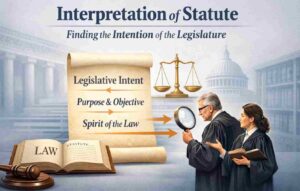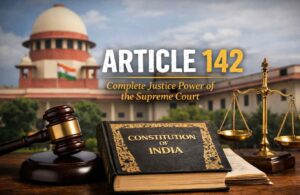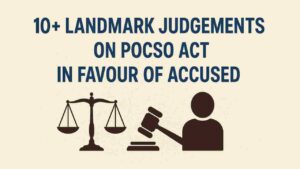The Doctrine of Severability means that if part of a law is unconstitutional, only that invalid portion is struck down, while the rest remains valid, if it can function independently and reflects the legislature’s intent. It ensures constitutional compliance without nullifying entire laws.
“The Constitution is not a fragile instrument. It bends but does not break.”
-Justice Vivian Bose (Kesavananda Bharati v. State of Kerala)
Imagine a situation, Parliament enacts a law with noble intent, but one small provision oversteps constitutional boundaries. Does that single excess taint the entire law? Or can we surgically remove the unconstitutional part and preserve the rest?
This is where the Doctrine of Severability steps in, a principle as pragmatic as it is profound. It embodies the judiciary’s attempt to maintain a delicate balance: on one hand, upholding constitutional supremacy, and on the other, respecting legislative intent.
As advocates, we often encounter this doctrine in constitutional litigation, especially while challenging the validity of statutes. It is not just a technical rule of interpretation, it’s a judicial philosophy, a reflection of constitutional resilience.
Core of Severability
At its simplest, the Doctrine of Severability means this:
If a part of a statute is unconstitutional, only that invalid portion should be struck down, provided the rest of the statute can survive independently and give effect to the legislative intent.
In other words, the bad must perish, but the good must endure.
It ensures that courts do not destroy more than necessary. The judiciary, in exercising its power of judicial review, does not rewrite legislation but performs a delicate surgery, removing the diseased part without killing the patient.
Constitutional Foundation of the Doctrine
Though not expressly stated in the Constitution of India, the doctrine finds implicit recognition in Article 13(1) and Article 13(2):
- Article 13(1) declares that all pre-Constitution laws inconsistent with fundamental rights shall be void to the extent of such inconsistency.
- Article 13(2) prohibits the State from making laws that abridge fundamental rights, and if it does, the law is void to the extent of contravention.
Notice that phrase,
“to the extent of such inconsistency.”
That small phrase breathes life into the doctrine of severability. It tells us that the Constitution itself contemplates partial invalidation, not total annihilation, when inconsistency arises.
Thus, the doctrine is not merely a judicial invention; it is constitutionally ordained.
Historical Origins: Borrowed, But Perfected
The doctrine has its roots in American constitutional law, particularly in the U.S. Supreme Court’s approach to the severability clause in legislation.
The U.S. courts developed the principle that unconstitutional provisions could be severed from valid ones if the statute’s core purpose could still be achieved.
India, while borrowing this principle, adapted it to its unique constitutional fabric. Unlike the American system, India’s legislative structure and social objectives are different — our courts have had to balance fundamental rights against directive principles and public interest.
Thus, while the seed was American, the plant that grew in Indian soil has its own distinct character.
The Test of Severability: What Must Be Asked
The courts do not mechanically apply severability. They apply a series of tests evolved through decades of judicial reasoning.
Let us examine the key criteria often applied:
(i) Can the valid and invalid parts be separated?
If the valid and invalid provisions are so intertwined that separating one would destroy the legislative scheme, severability cannot apply.
(ii) Would the legislature have enacted the valid part without the invalid one?
This is a question of legislative intent. If Parliament would not have passed the law minus the offending part, the entire law must fall.
(iii) Does the remaining portion still conform to constitutional requirements?
The surviving part must not become arbitrary, meaningless, or incomplete.
(iv) Is the valid portion capable of being enforced independently?
A provision may be constitutional in theory but unenforceable in practice without the severed part.
(v) Is the invalid portion so trivial that it doesn’t affect the law’s core?
Sometimes the unconstitutional clause is peripheral. In such cases, the doctrine protects the law’s main body.
The Landmark Cases that Shaped Severability in India
Let’s journey through the leading precedents, where this doctrine found life, application, and nuance.
(a) R.M.D. Chamarbaugwala v. Union of India (1957 SCR 930)
This case remains the cornerstone of the doctrine in India. The issue revolved around the constitutional validity of certain provisions of the Bombay Lotteries and Prize Competitions Act, 1948.
The Supreme Court held that only those provisions dealing with gambling activities were invalid, as they violated fundamental rights under Article 19(1)(g). However, provisions regulating games of skill were valid.
Justice Venkatarama Ayyar laid down the classic tests for severability. His words still echo in every constitutional court today:
“If the valid and invalid provisions are so inextricably mixed up that they cannot be separated without leaving an incomplete or more or less mutilated remainder, then the whole must be struck down.”
(b) State of Bombay v. F.N. Balsara (1951 SCR 682)
Here, parts of the Bombay Prohibition Act, 1949 were challenged. The court upheld certain sections while striking down others that imposed unreasonable restrictions on personal liberty.
The judgment reaffirmed that the invalid portions — which imposed disproportionate restrictions, could be severed from the valid regulatory framework.
It was one of the earliest and finest illustrations of judicial restraint — the court refused to destroy a socially beneficial law merely because one limb was infirm.
(c) A.K. Gopalan v. State of Madras (1950 SCR 88)
Although primarily remembered for the debate on personal liberty under Article 21, this case also reflected early judicial hesitance in applying severability liberally. The court upheld the Preventive Detention Act after severing certain sections, reflecting its initial caution in constitutional surgery.
(d) Minerva Mills Ltd. v. Union of India (1980 AIR 1789)
Perhaps the most elegant example of severability applied in a constitutional amendment context. The Supreme Court struck down Sections 4 and 55 of the 42nd Amendment, which gave primacy to Directive Principles over Fundamental Rights.
The Court held those sections to be violative of the basic structure but preserved the rest of the amendment. Thus, severability was extended beyond ordinary laws to the realm of constitutional amendments.
(e) Kihoto Hollohan v. Zachillhu (1992 Supp (2) SCC 651)
In this landmark case concerning the Tenth Schedule (Anti-Defection Law), the Supreme Court struck down Paragraph 7 (which barred judicial review) as unconstitutional, while upholding the rest of the schedule.
This was a masterstroke of judicial balance, protecting legislative integrity while preserving the constitutional guarantee of judicial review.
(f) Shayara Bano v. Union of India (2017 9 SCC 1)
The famous Triple Talaq case reaffirmed the doctrine’s modern vitality. The court struck down Talaq-e-Biddat (instant triple talaq) as unconstitutional but left the rest of Muslim personal law untouched.
This decision demonstrated that severability is not confined to statutes, it extends to customs and practices, wherever constitutional scrutiny applies.
The Logic Behind Severability: Why It Matters
The doctrine is not merely about saving legislative drafts. It is rooted in constitutional philosophy, a respect for
democracy and institutional boundaries.
When courts apply severability, they acknowledge that Parliament represents the will of the people. Striking down an entire law without necessity would amount to judicial overreach.
Yet, at the same time, constitutional supremacy requires that unconstitutional provisions cannot be allowed to survive.
Thus, severability acts as a bridge between judicial vigilance and legislative respect.
Severability vs. Eclipse
Students often confuse the Doctrine of Severability with the Doctrine of Eclipse. Though related, they differ fundamentally.
- Severability applies when a law is unconstitutional ab initio, from the very beginning.
- Eclipse applies when a law, valid when made, later becomes void due to constitutional changes (for example, post-enactment of fundamental rights).
Under severability, the unconstitutional part is dead.
Under eclipse, it is shadowed and may revive if the inconsistency is removed.
The Role of Legislative Intent
One of the trickiest aspects of applying severability lies in determining legislative intent.
The court must ask: Would Parliament have passed this law even without the offending provision?
For instance, if a penal provision is central to a regulatory statute, removing it may render the law toothless, indicating that Parliament would not have enacted it in such form. In that case, the whole law falls.
On the other hand, if the invalid part is an independent limb or an ancillary mechanism, the rest of the law survives.
This analysis is not purely mechanical. It requires sensitivity to the context, purpose, and policy of the legislation.
As advocates, this is where our interpretative skill matters most, persuading the court that either the law’s spirit survives or that its core collapses.
Judicial Craftsmanship
If one reads the major judgments carefully, one finds that severability is not merely a doctrine, it’s a judicial art form. It reflects the temperament of constitutional courts.
- In conservative eras, courts have used it cautiously to preserve legislative policy.
- In progressive eras, courts have used it boldly to excise unconstitutional excesses while keeping the rest intact.
Yet, in both moods, the underlying principle remains constant, respect the Constitution, but preserve democracy.
Criticisms and Limitations
No doctrine is perfect. Severability, too, invites criticism.
(i) Risk of Judicial Legislation
By severing parts and keeping others, courts sometimes end up re-drafting the law, something critics call “judicial law-making.”
(ii) Legislative Intent Is Not Always Clear
Determining whether Parliament would have passed the law without the offending part is speculative. Courts must often infer intent from silence.
(iii) Fragmented Legislation
Partial invalidation can sometimes produce disjointed statutes, incomplete, confusing, or difficult to enforce.
(iv) Absence of Severability Clauses
In India, unlike in the U.S., most statutes do not contain explicit “severability clauses.” Courts must therefore rely entirely on interpretation.
Yet, despite these limitations, the doctrine survives because it is indispensable — it prevents the constitutional order from swinging between extremes of judicial activism and legislative absolutism.
Modern Relevance: In the Era of Judicial Review
In today’s India, where legislative power expands rapidly and constitutional challenges multiply, the Doctrine of Severability has never been more relevant.
Recent cases involving privacy, internet regulation, and freedom of expression show the judiciary’s consistent reliance on this doctrine.
For instance, in Justice K.S. Puttaswamy v. Union of India (2017 10 SCC 1), the court relied on partial invalidation while dealing with Aadhaar-related provisions. The judiciary meticulously separated the constitutional core of welfare delivery from the unconstitutional compulsion of data disclosure.
This fine-grained judicial craftsmanship is the modern face of severability.
The Advocate’s Perspective: Arguing Severability in Court
From a practitioner’s lens, arguing severability demands strategic clarity.
When challenging a statute:
- Always emphasize that the unconstitutional provision is integral to the legislative scheme.
- Argue that once it is removed, the law loses coherence and must be struck down entirely.
When defending a statute:
- Emphasize that the invalid provision is incidental or ancillary.
- Show that the rest of the law serves a legitimate purpose and can function effectively without the severed part.
Judges appreciate advocates who understand this nuance, who know when to wield the scalpel and when to ask for amputation.
Comparative Glance: Other Jurisdictions
United States
In the U.S., statutes often contain explicit “severability clauses,” instructing courts to preserve valid portions. Yet, even without such clauses, U.S. courts apply the doctrine liberally.
United Kingdom
Since the UK follows the doctrine of Parliamentary sovereignty, courts traditionally lack power to strike down legislation. Severability arises mostly in subordinate legislation or in Human Rights Act cases.
Canada and Australia
These jurisdictions, like India, have constitutional supremacy and follow a similar severability principle, though often influenced by proportionality and reasonableness tests.
India stands uniquely balanced, constitutional but democratic, judicial yet deferential.
Verdict: The Living Spirit of the Constitution
The Doctrine of Severability is not just a legal rule; it’s a constitutional ethic, one that embodies restraint, respect, and reason.
It teaches us that the Constitution is not an instrument of destruction. Its purpose is not to strike down laws eagerly but to preserve justice thoughtfully.
As advocates, we must remember that every time we invoke this doctrine, we are engaging in a dialogue between the legislature’s will and the Constitution’s wisdom.
The power to sever is the power to save.
And in that saving lies the survival of constitutional democracy itself.
Follow The Legal QnA For More Updates…















